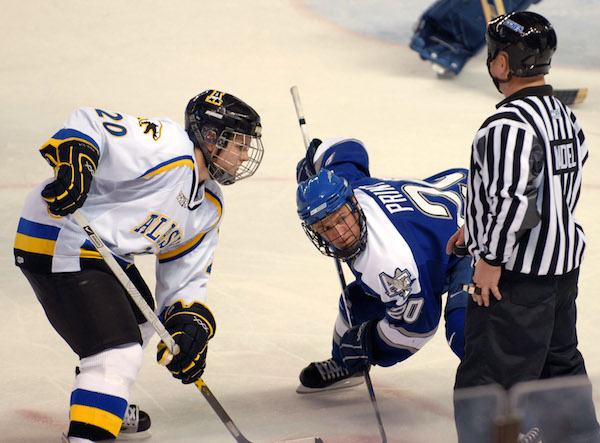You have to be tough to play sports. That’s a central message of most sports cultures that gets hammered into athletes brains from a very young age. Sports culture is fairly unyielding on this principal. “Walk it off.” “There’s a difference between being hurt and being injured.” “Rub some dirt on it.” These common phrases are just some of the ways that parents, coaches, and peers all reinforce that core tenant of sports, playing through pain. We also honor professional athletes who play through pain. Michael Jordan’s flu game, where he scored 38 points despite being visibly ill is legendary. Willis Reed coming out to play in game seven of the 1970 NBA finals despite having a torn thigh muscle is equally famous. In baseball, Kirk Gibson’s hobbled home run in the 1988 World Series remains one of the most famous plays ever. Football players make playing through injury so routine that you needn’t look farther back than a few weeks ago when quarterback Tony Romo broke two bones in his lower back and came back to finish the game. No sport lives its injury ethos more diligently than hockey. In the 2013 playoffs, Gregory Campbell broke his leg during a penalty kill and played on it for more than a minute before getting to the bench. In that same playoffs, Campbell’s teammate Patrice Bergeron played through broken ribs, torn cartilage around the ribs, a punctured lung, and a separated shoulder. Just this season, Olli Maata, played with a cancerous throat tumor. He played until his scheduled surgery, which doctors think was successful, and is now back skating, ahead of schedule to return for his team. Not only does hockey culture demand this of its players, but it demands that they play through injury immediately (thus the phrase, “player A [suffered this injury] and didn’t miss a shift”) but without complaint.
Playing through pain isn’t always a good thing. We now know that ignoring the effects of brain injuries is a very, very bad thing to do. The culture is slowly shifting to be more permissive of players who voluntarily report injuries or who choose to sit out a game or two to get healthy. This is almost definitely for the best but it’s easy, when in the midst of a cultural shift, to forget the benefits of the element of the culture that is changing. There are real benefits to the principals of toughness that sports instills in its participants. Most of us who play sports don’t become professional athletes. We’ll never need to play basketball while unable to properly walk or hockey while in intense pain but all of us are people who, at some point in our lives, will face intense challenges. Whether it’s fighting through a flu to watch your child perform in something important to them or suffering from a disease or handling the anguish of a loved one’s death or giving birth, no one makes it through life without being faced with a painful situation. The benefit of learning toughness from sports is that it’s there when you need it.
Nowhere is the benefit of having learned toughness from sports more clear than in the amazing story of Mikey Nichols. Brought to us by Steve Politi of NJ.com, this is a truly inspiring story. Nichols was playing hockey for his high school team from Monroe, NJ, when he suffered an injury to his spine which left him paralyzed:
He was chasing a puck in the corner when he was checked from behind. “I remember sliding into the boards and thinking, ‘Oh (shoot), I’m going to get a concussion. I don’t want to miss a shift.’ And then I hit the boards.”
He knew something was very wrong.
“Mikey, you good?” his best friend asked.
“I’m fine, bro. I just can’t move anything.”
Hockey culture informs its players that they should respond to all injuries with casual indifference. Yes, he’s fine. He just can’t feel his body. But he’s fine. Viewed from afar, the fact that the sport Nichols loves might have informed how he responded to a catastrophic injury he suffered while playing the sport may seem like not nearly enough to balance the scales in favor of hockey and sports culture. But when you read Politi’s article, you get a sense for how amazing Nichols is and how having grown up a hockey fan and player doesn’t just inform the moments after the injury, that it’s going to be a part of who he is forever, no matter what challenges he faces, then you start to think about things differently.
“To play in the NHL, of course,” is what Mikey will say when you ask him his goals. But then he’ll get serious. He’ll talk about his parents and the sacrifices they’ve made. “I want to be able to do everything I used to take for granted, and now I wished I had back.”
Maybe it’s The Big Idea that’ll give him that. Maybe it’ll be some other promising research. But, after spending the past 10 months meeting other people with spinal-cord injuries and benefitting from their help, he hasn’t lost hope.
“I want everyone who’s ever had to be in a wheelchair to walk again,” he said. “And to get a second chance.”
Getting paralyzed during a sporting event is horrible and I wish it never happened. There are some common-sense things hockey could change to avoid more of these injuries and they should absolutely do them. They are rare though. Nichols is one of the small percentage of people who suffer a life-changing injury playing sports but his attitude is an inspiring reminder that the lessons taught in sports can help all of us overcome (the hopefully smaller) the challenges that life presents to us. Just remember, if Nichols can figuratively say of himself, “hockey player becomes a paraplegic, doesn’t miss a shift” we can do it too.

